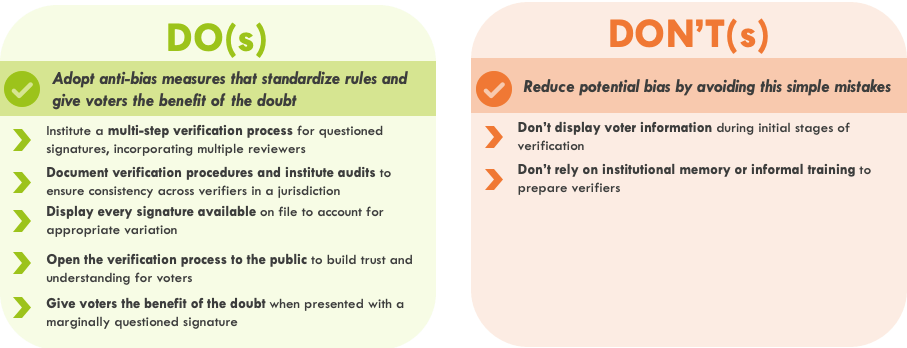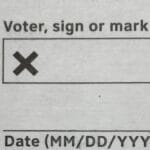HIGHLIGHTS
- Incorporate anti-bias measures into signature verification
- Reinforce signature requirements through multiple voter outreach channels
- Highlight opportunities for voters to fix errors
Vote-by-mail systems include safeguards to verify voters’ identities, like signature verification or personal identification numbers. However, unlike at the polls where verification often happens in front of the voter (i.e. when they check-in with poll workers), much of the mail ballot verification process is out of sight. The less visible parts of this process can create gaps in understanding for voters, which may lead them to make simple mistakes or lose confidence in the election system. Simple best practices and design recommendations reduce common mistakes and increase voter confidence.
Institute simple anti bias measures into the signature verification process to help all voters receive equal treatment. Election workers are required to make many rapid decisions when validating ballots, which can introduce bias. Voter demographic information, for example, may be
Institute simple anti bias measures into the signature verification process to help all voters receive equal treatment. Election workers are required to make many rapid decisions when validating ballots, which can introduce bias. Voter demographic information, for example, may be available to election workers during verification and could unconsciously impact decisions, despite not necessarily being relevant to initial verification. Luckily, simple solutions can guard against biased decision making. For example, a voter’s neighborhood, race, or age should be hidden from verifiers during their initial review so they can focus only on the most relevant information – the signatures in front of them. The visual below presents a set of do’s and don’ts that election offices can adopt to make the verification process more fair and equitable.
Voter outreach materials should make signature requirements and the matching process salient to voters. In this election cycle, millions of voters will be voting by mail for the first time and may not know or understand the importance of signing
Voter outreach materials should make signature requirements and the matching process salient to voters. In this election cycle, millions of voters will be voting by mail for the first time and may not know or understand the importance of signing their ballots with their “official signature,” matching their signature that’s on file. Without overwhelming voters with details about the process, outreach materials (especially ballot chase messages delivered when voters have a ballot in hand) should include reminders about the signature requirement and provide simple heuristics that encourage signing with care.
Election officials and GOTV organizations should incorporate ballot curing information when explaining how voting by mail works. The growing attention on ballot rejections may undermine voter confidence in vote-by-mail systems and, ultimately, reduce turnout. When explaining how the mail-in process
Election officials and GOTV organizations should incorporate ballot curing information when explaining how voting by mail works. The growing attention on ballot rejections may undermine voter confidence in vote-by-mail systems and, ultimately, reduce turnout. When explaining how the mail-in process works, be mindful not to overemphasize the likelihood of ballot errors, but rather, frame the curing process as a failsafe to ensure all votes are counted. Familiarity with the process can also build awareness among voters who may otherwise misunderstand or question the legitimacy of curing notices.








